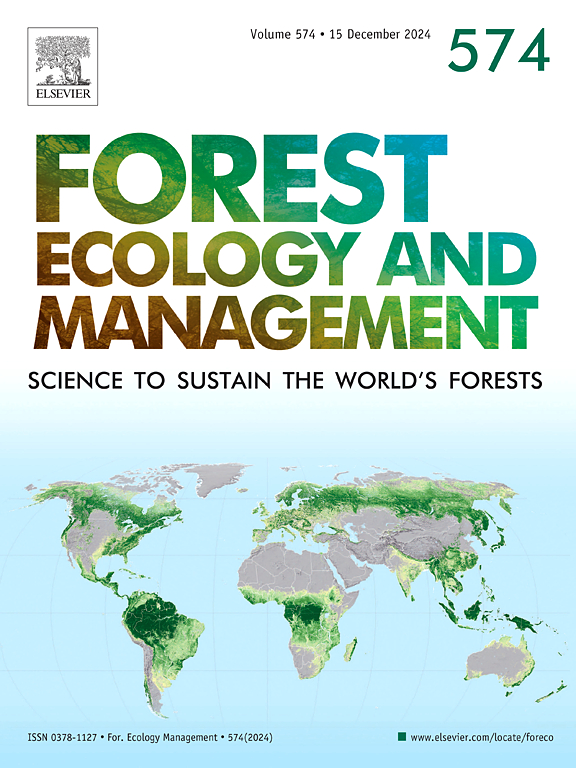间伐提高森林抗旱、虫害、风暴和火灾能力的潜力:一项荟萃分析
IF 3.7
2区 农林科学
Q1 FORESTRY
引用次数: 0
摘要
随着更严重和频繁的自然干扰的发生,对森林生态系统的压力越来越大,越来越明显地需要进行造林处理以减轻多重风险。间伐已被确定为一种管理林分以增强恢复力和抵抗干扰的手段。然而,潜在的机制因干扰类型和树种而异,缺乏经验证据表明间伐可以有效地在大范围内减轻这些风险。我们对50项研究进行了荟萃分析,量化了间伐处理对林分对四类自然干扰(干旱、病虫害、风和火)的恢复力和抵抗力的影响。进行meta分析以检验各种调节因子的影响,即响应类型(生长、存活、损害)、间伐强度、间伐类型、自第一次处理以来的时间、林龄和害虫类型(针对昆虫和病原体)。我们发现,间伐对森林的恢复力和抵抗力具有广泛的积极影响,而干扰特定的影响对减少干旱、害虫和某些情况下的火灾的影响是积极的,但对风暴的影响不显著。尽管对干扰类型的反应各不相同,在某些情况下,反应类型、变薄类型和治疗后的时间也各不相同,但本研究的一个关键发现是,就我们的恢复力和抗性指标而言,没有发现统计学上显著的变薄负面影响。虽然间伐不应该被认为是一种单独增加森林恢复力的工具,但我们的研究结果表明,对于北美和欧洲的温带和北方生态系统,间伐可以预期增加森林对多种压力源的恢复力和抵抗力,在广泛的立地和林分特征中。然而,需要来自亚洲、南半球和热带森林的经验数据才能得出全球范围的结论。此外,应仔细评估间伐对森林生态的潜在有害影响,然后再优先考虑将间伐作为提高森林恢复力和抵抗力的手段。本文章由计算机程序翻译,如有差异,请以英文原文为准。
Potential of thinning to increase forest resilience and resistance to drought, pest, windstorm and fire: A meta-analysis
As the pressure on forest ecosystems increases with the occurrence of more severe and frequent natural disturbances, the need for silvicultural treatments to mitigate multiple risks is becoming increasingly apparent. Thinning has been identified as a means of managing stands to enhance resilience and resistance to disturbances. However, the underlying mechanisms vary depending on the disturbance types and tree species and there is a lack of empirical evidence that thinning can effectively mitigate these risks at a broad scale. We conducted a meta-analysis of 50 studies quantifying the effects of thinning treatments on the resilience and resistance of forest stands to four categories of natural disturbances: drought, insects and pathogens, wind, and fire. Meta-analyses were conducted to examine the influence of various moderators, namely the response type (growth, survival, damage), thinning intensity, thinning type, time since the first treatment, stand age and pest type (for insects and pathogens). We found a positive broad-scale effect of thinning on forest resilience and resistance, while the disturbance-specific effect was positive for reducing the impact of drought, pests, and in some cases fire, but not significant for windstorms. Although responses varied among disturbance types, and in some cases response type, thinning type, and time since treatment, a key finding of this study is that no statistically significant negative effect of thinning has been detected with respect to our resilience and resistance indicators. Although thinning should not be considered as a tool that will singlehandedly increase the resilience of forests, our results suggest that for temperate and boreal ecosystems of North America and Europe, thinning can be expected to increase the resilience and resistance of forests to multiple stressors, in a wide range of sites and stand characteristics. Yet, empirical data from Asia, southern hemisphere and tropical forests are needed to enable global-scale conclusions. Moreover, potential detrimental effects of thinning on forest ecology should be carefully assessed before prioritizing thinning as a means of increasing forest resilience and resistance.
求助全文
通过发布文献求助,成功后即可免费获取论文全文。
去求助
来源期刊

Forest Ecology and Management
农林科学-林学
CiteScore
7.50
自引率
10.80%
发文量
665
审稿时长
39 days
期刊介绍:
Forest Ecology and Management publishes scientific articles linking forest ecology with forest management, focusing on the application of biological, ecological and social knowledge to the management and conservation of plantations and natural forests. The scope of the journal includes all forest ecosystems of the world.
A peer-review process ensures the quality and international interest of the manuscripts accepted for publication. The journal encourages communication between scientists in disparate fields who share a common interest in ecology and forest management, bridging the gap between research workers and forest managers.
We encourage submission of papers that will have the strongest interest and value to the Journal''s international readership. Some key features of papers with strong interest include:
1. Clear connections between the ecology and management of forests;
2. Novel ideas or approaches to important challenges in forest ecology and management;
3. Studies that address a population of interest beyond the scale of single research sites, Three key points in the design of forest experiments, Forest Ecology and Management 255 (2008) 2022-2023);
4. Review Articles on timely, important topics. Authors are welcome to contact one of the editors to discuss the suitability of a potential review manuscript.
The Journal encourages proposals for special issues examining important areas of forest ecology and management. Potential guest editors should contact any of the Editors to begin discussions about topics, potential papers, and other details.
 求助内容:
求助内容: 应助结果提醒方式:
应助结果提醒方式:


